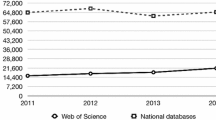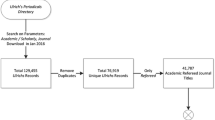Abstract
Bibliometric research can provide science policy makers with indicators of the capacity of a country's national scientific system to produce printed information. The capacity of the local publishing industry to produce scientific and technical periodical publications reflects the availability of outlets for the dissemination of scientific findings. The present research attempts to evaluate the role of the publishing industry in the level of bibliographic control, and the level of peer review of periodical publications from Latin America. A random search was performed on the 1990 Cd-Rom version ofThe Serials Directory, a commercially produced international reference source on periodical publications. A sample of 311 periodicals from Latin America was downloaded to a local database. A similar search was performed on publications from the United States and the United Kingdom for comparison purposes. A random search of 235 publications was downloaded into a local database. Publishers were classified for both samples according to three types: academic, governmental, and commercial. Publications were sorted thematically and indicators of bibliographic control, and of peer review were recorded for both samples. Publications from Latin America showed a very low level of bibliographic control, particularly in the case of the assignment of ISSN numbers, where 58% of the sample studied was published without this element of bibliographic control. This contrasted sharply with the periodicals from the US and UK, where 83% (195) journals had an ISSN number assigned. The involvement of editorial boards in the academic quality of Latin American publications amounted only to 21% of the sample studied. Periodicals from the US and UK reported an editor as responsible for the journal in 40% (93) of the cases. This amount constitutes about double the number of editors reported by Latin American publications. Latin American academic publishers are the most numerous publishers in the sample studied accounting for 37% (114) of the journals studied however, 68% (77) of those editors printed periodicals without a named editor. Governmental publishers are the second largest publisher type. They produced 29% (89) of the journals in the sample. Commercial publishers are responsible for 26% (82) of the journals studied. Publications from the US and UK show a clear predominance of commercial publishers, accounting for 47% (111) of the journals. Academic publishers only produced 29% (68) of the 235 journals in the sample. This clear dominance of the commercial publisher sector shows that publishing in at least the two countries studied is clearly practised as a business enterprise. This is in sharp comparison to the publishing patterns exhibited in Latin America where the academic sector is the most prominent one.
Similar content being viewed by others
References and notes
Garvey, B. C. Griffith, Informal channels of communication in the behavioural sciences: their relevance in the structuring of formal or bibliographic control. In:Foundation of Access to Knowledge, a Symposium, Syracuse: Syracuse University Press, 1968.
The publication of research results in scientific journals is presently interpreted as the end product or research in a final and public form, and the nature of the information contained in the scientific journal is both formal and repository. Nonetheless, scientists continue to submit manuscripts for publications although their motivation might be more linked to the present reward systems of competitive science than to the desire for communication. For more information on this seeJ. R. Ravetz,Scientific Knowledge and its Social Problems, Oxford, Clarendon Press, 1971, p. 282.
The problems of the publishing industry in DCs has however been explored by researchers in library and information science. SeeT. Mlaki, Serials of the poor nations: their nature, importance, problems and suggested solutionsInternational Cataloguing: 14 (4) (1985) 39–41 orR. Dougherty, The state of professional publishing in non-industrialized nations,Ifla Journal, 8 (3) (1982) 273–277. For an earlier assessment of the problems of bibliographic control in Latin American Serials, viewed from the perspective of a professional bibliographer seeA. V. Tjarks, Coping with Latin American serials,Serials Librarian, 3 (4) (1979) 407–415.
B. Sorokin, S. Maricic, Z. Papes, Life of domestic periodicals in Croatia,Scientia Yugoslavica, 16 (1990) 163–178.
S. Maricic, B. Sorokin, Z. Papes, Scientific communicability indicators for the periodicals in the Croatian bibliography, Series B,Informatologia, 24 (3) (1992) 109–128.
S. Maricic, Evaluating periodicals at the scientific periphery. Review article,IASLIC Bulletin, 38 (1993) 1–16.
D. Price, Networks of scientific papers. The pattern of bibliographic references indicates the nature of the scientific research front,Science, 149 (1968) 510–515.
V. Cano, Bibliometric control and international visibility of Latin American periodical publications, In:Science Indicators for Developing Countries,R. Arvanitis,J. Gaillard (Eds), Paris, Editions Orstom, 1992, pp. 511–526.
V. Cano, Periodicals from developing countries: Bibliographic control & visibility,International Information Communication and Education, 12 (2) (1993) 143–164.
V. Cano, International visibility of periodicals from Ireland, India and Latin America,Knowledge and Policy, 6 (3–4) (1993–94) 55–78.
J. Martyn, Proliferation and fragmentation of journals. In:The Scientific Journal,A. J. Meadows (Ed.), London, ASLIB, 1979, pp. 68–70.
J. Jarvis, Costs and full cost recovery: Budgeting for journals and justifying new journals, In:Learned Journals: The Problems of Pricing and Buying Around, Letchworth, Herts: Epsilon Press, 1985, pp. 1–9.
R. Campbell, The publisher's position: Survival in an electronic world, In:Changing Roles in Information Distribution,Ann Marie Cunningham,W. Wicks (Eds), Philadelphia, Penn: NFAIS, 1993, pp. 39–63.
For examples, seeC. P. Bourne, The worlds technical journal literature: an estimate of volume, origin, language, field, indexing and abstracting,American Documentation, (April, 1962) 159–168,C. M. Gottschalk, W. F. Desmond, Worldwide census of scientific and technical serials,American Documentation, (July, 188–190).M. Carpenter, F. Narin, The subject composition of the worlds scientific journals,Scientometrics, 2 (1980) 53–63.
M. Gordon, Deficiencies of scientific information access and output in less developed countries,Journal of the American Society for Information Science, (November (1979) 340–342).Gordon argues in favour of “more international scientific pursuits” from developing countries. However, it can be seen that such a policy goes against the development of local invisible colleges as it thwarts their own publication outlets, seeH. Vessuri, 1986. “La Publicacion Cientifica Latinoamericana como Vehiculo de Fortalecimiento de la Capacidad Cientifica Regional.”Mimeo, p. 32.
M. Schoijet, R. Worthington, Globalization of science and repression of scientists in Mexico,Science, Technology and Human Values, 18 (2) (1993) 209–230.
For an example of the degree of technical and qualitative improvements sought in Latin American periodicals seeT. Arends, Las Revistas medicas venezolanas: evaluacion de su calidad,Acta Cientifica Venezolana, 19 (1968) 148–151.
C. McNight The electronic journal: a user's perspective,Serials, 6 (1) (1993) 13–19.
M. Stangelove, D. Kovacs,Directory of Electronic Journals, Newsletters and Academic Discussion Lists, Washington DC, Association of Research Libraries, 1992, p. 241.
E. Garfield, Electronic journals and skywriting: a complementary medium for scientific communication?Current Contents, 45 (1991) 5–8.
G. Taubes, Publication by electronic mail takes physics by storm,Science, 259 (Feb. 1993) 1246–1248.
R. Campbell, Document delivery and the journal publishers,Scholarly Publishing, 3 (4) (1992) 213–221.
Author information
Authors and Affiliations
Rights and permissions
About this article
Cite this article
Cano, V. Characteristics of the publishing infrastructure of peripheral countries: A comparison of periodical publications from Latin America with periodicals from the US and the UK. Scientometrics 34, 121–138 (1995). https://doi.org/10.1007/BF02019177
Received:
Issue Date:
DOI: https://doi.org/10.1007/BF02019177




